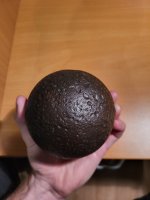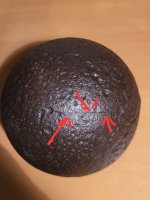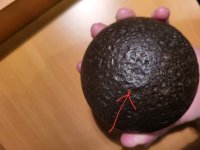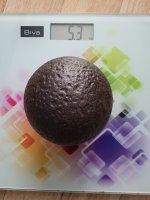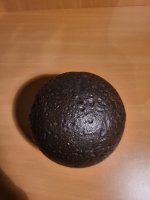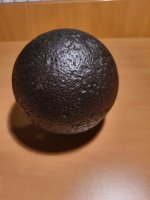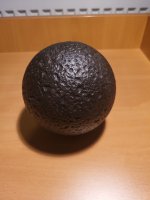Hi,
a few days ago I recived 12pdr Napoleon solid shot. What would you say, is it original? I asked this question on a few FB groups and the replies said it is original, but I would also appreciate your opinions. I bought it from civil war relic shop trough their website, where it says that it was found (excavated) in northern Verginia. The cannonball has quite a lot of pitting all around. You can barely see the mold seam. 90° from mold seam is a really small flat area or depression (about 0.6 inch) which I belive is where the mold vent was. Maybe the molten iron there collapsed a little while cooling? (Or is just heavier pitting). Otherwise is nicely round. The ball is a little lighter at 11.68 pounds (5.3-5.4 kg on a bathroom scale) maybe due to heavy pitting, air bubbles inside cannonbal (casting flaw) or exposure to acidic groundwater? The diameter is also a little smaller at 14.46 inches, but probably because of a lot of pitting?
Thanks, and have a great day!
a few days ago I recived 12pdr Napoleon solid shot. What would you say, is it original? I asked this question on a few FB groups and the replies said it is original, but I would also appreciate your opinions. I bought it from civil war relic shop trough their website, where it says that it was found (excavated) in northern Verginia. The cannonball has quite a lot of pitting all around. You can barely see the mold seam. 90° from mold seam is a really small flat area or depression (about 0.6 inch) which I belive is where the mold vent was. Maybe the molten iron there collapsed a little while cooling? (Or is just heavier pitting). Otherwise is nicely round. The ball is a little lighter at 11.68 pounds (5.3-5.4 kg on a bathroom scale) maybe due to heavy pitting, air bubbles inside cannonbal (casting flaw) or exposure to acidic groundwater? The diameter is also a little smaller at 14.46 inches, but probably because of a lot of pitting?
Thanks, and have a great day!


